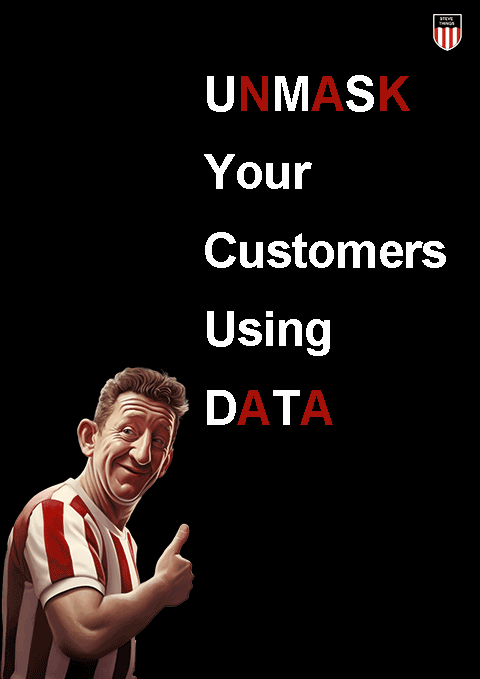I realise the headline is a bit geeky so first let me explain what we're talking about.
First party data refers to data that is collected and owned by your company for its own use. This can include data that is collected directly from your customers, such as through online forms or surveys, as well as data that is generated by your company's own systems, such as website usage data or transaction records. First party data is much more valuable than other data sources because it is directly controlled and owned by you, and can be used to gain insights into your customer behaviour and preferences.
So what about a first party persona?
Personas are fictional representations of a website's users. 1st party data driven persona's are the same but the difference is that they are created using data from identified customers or prospects. First-party cookies are cookies that are set by the website that a user is visiting, and they can be used to track user behaviour and other information on your website.
By creating personas using first-party cookie data, you can gain insights into your users and avoid annoying users by following them around the web using 3rd party cookies.
What's wrong with 3rd party cookies then?
Well, there are a few reasons why a third-party cookie strategy might not be as effective in the future as they are today.
For one, many web browsers are starting to phase out support for third-party cookies (specifically Google, Microsoft and Apple, meaning browsers near you - like 99% of them).
This means that websites won't be able to track users across different sites using third-party cookies, making it harder to personalise the user experience mainly for advertising purposes. In other words it's the death of adverts following you around the web.
On top of that, people are becoming more privacy-conscious, so it might be tougher for companies to collect and use data from third-party cookies. That's why a lot of marketers are turning to alternative strategies, like using first-party cookies or other data sources, to deliver personalised experiences to their users.
So how do you create a 1st party cookie strategy?
To create a first party cookie strategy, your website can set first party cookies on a user's device when they visit your website. This can be done easily with for instance a CDP sending data to Google Analytics (GA4) or more traditionally using GTM to send the data to GA4 on its own.
Once you've tracked the user behaviour and other information on the website, you can then use this data to create personalised user personas and to deliver targeted content and experiences to users based on their behaviour and interests. Not only that but you can also use your CDP customer data (from other than website sources) to feed into a user segment in your analytics system. This allows you to understand how customers whose behaviours match your anonymous users might behave and it's not a traditional use of a CDP.
How does it work traditionally?
Imagine that an anonymous user visits an online travel guide and browses the site for several minutes. The website sets a first party cookie on the user's device, which tracks the pages that the user views and the experiences that they are interested in. You can build an idea of the type of interests the user might have and map that to other attributes manually yourself.
Now imagine the user then identifies themselves by buying something like a fishing trip on that website.

Let's assume we're talking about the guy from Australia who likes fishing. That is because I have uncovered that according to the purchase made he was a man, he was from Australia and the category he was interested in was fishing. Additionally his first party cookie showed all of the services he looked at before he chose fishing and identified himself through the purchase.
So the next time he visits, I might display personalised product recommendations on the homepage based on the his previous browsing behaviour (not just fishing). Or, I could send the customer a targeted email marketing campaign featuring items that are similar to the ones that they viewed. By using first party cookie data in this way, you can create a more personalised and engaging user experience for the type of customers you know.
How does a CDP enrich this process?
So now, let's say that you have implemented a customer data platform (CDP) to manage and analyse the same data. When a user visits the site and the first party cookie is set, the data from the cookie is automatically sent to the CDP. The CDP can then send the data to multiple platforms and enrich all the platforms with the same information.
Your persona might include information such as the user's age, gender, preferred fishing type, and other relevant details - enriched by other data sources which are also linked through the CDP. So instead of having the customer information in one place (IE your CRM), the browsing information in another (IE Google Analytics) and the demographic information in another silo (IE; Clearbit) you use a CDP to connect them altogether - or at least enrich all data sources with the same information.
The CDP can also help to keep the user persona up to date by continuing to track the user's behaviour on the website and updating the persona accordingly in your marketing systems, IE PipeDrive, Hubspot or Salesforce. Additionally, the CDP can help you to integrate data from other sources, such as social media profiles and email marketing lists, to create a more comprehensive view of the user. If you can also push the data in your own data warehouse you have a powerful combination of 1st party data about that user from multiple sources that the CDP can then analyse to create a lookalike audience.

So what's a lookalike audience?
A lookalike audience is a group of individuals who have similar characteristics to your target audience. This is typically created by analysing customer data (i.e. The Ozzie Fisherman) to identify common characteristics among a group of valuable customers, and then using machine learning algorithms to find other individuals who have similar characteristics.
Lookalike audiences can then be used in marketing and advertising to reach new potential customers who are likely to be interested in a business's products or services (in this case charter fishing).
To create a lookalike audience from a customer data platform (CDP), you would first need to collect and organise customer data in the CDP as mentioned earlier. Once you have this data organised, you can use the CDP's analytics tools to identify common characteristics among your most valuable customers, such as their age, location, and interests. With this information, you can then create a "seed" audience that represents these characteristics.
This my friends is your data driven 1st party persona.
Next, you can use the platforms such as Facebook and Google's lookalike audience features to find other individuals who have similar characteristics to your seed audience. This can help you reach new potential customers who are likely to be interested in your products or services.
Once you have identified your lookalike audience, you can use the CDP to target your marketing efforts to these individuals, either through ads on social media or other online platforms, or by using the CDP's integrations with other marketing tools. This can help you reach a larger and more relevant audience, and potentially drive more conversions and sales for your business. A CDP can power all of the work from one place.
Beware the legal implications and you'll be fine
In order to create a successful first party cookie strategy, it is important you are transparent with your users about the data you collect and to provide them with the ability to opt out of tracking if they prefer. Additionally, it is essential to ensure that the data collected is secure and is used in accordance with privacy laws and regulations, specifically things like the GDPR. But that is a whole new article.

